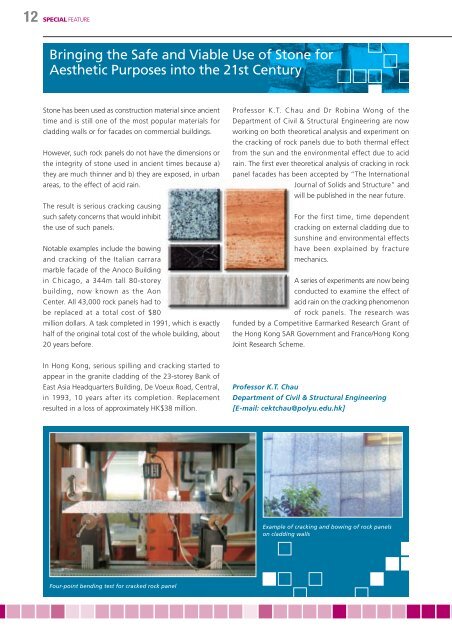Issue No. 3 (November 2006) - The Hong Kong Polytechnic University
Issue No. 3 (November 2006) - The Hong Kong Polytechnic University
Issue No. 3 (November 2006) - The Hong Kong Polytechnic University
Create successful ePaper yourself
Turn your PDF publications into a flip-book with our unique Google optimized e-Paper software.
12<br />
SPECIAL FEATURE<br />
Bringing the Safe and Viable Use of Stone for<br />
Aesthetic Purposes into the 21st Century<br />
Stone has been used as construction material since ancient<br />
time and is still one of the most popular materials for<br />
cladding walls or for facades on commercial buildings.<br />
However, such rock panels do not have the dimensions or<br />
the integrity of stone used in ancient times because a)<br />
they are much thinner and b) they are exposed, in urban<br />
areas, to the effect of acid rain.<br />
<strong>The</strong> result is serious cracking causing<br />
such safety concerns that would inhibit<br />
the use of such panels.<br />
<strong>No</strong>table examples include the bowing<br />
and cracking of the Italian carrara<br />
marble facade of the Anoco Building<br />
in Chicago, a 344m tall 80-storey<br />
building, now known as the Aon<br />
Center. All 43,000 rock panels had to<br />
be replaced at a total cost of $80<br />
million dollars. A task completed in 1991, which is exactly<br />
half of the original total cost of the whole building, about<br />
20 years before.<br />
Professor K.T. Chau and Dr Robina Wong of the<br />
Department of Civil & Structural Engineering are now<br />
working on both theoretical analysis and experiment on<br />
the cracking of rock panels due to both thermal effect<br />
from the sun and the environmental effect due to acid<br />
rain. <strong>The</strong> first ever theoretical analysis of cracking in rock<br />
panel facades has been accepted by “<strong>The</strong> International<br />
Journal of Solids and Structure” and<br />
will be published in the near future.<br />
For the first time, time dependent<br />
cracking on external cladding due to<br />
sunshine and environmental effects<br />
have been explained by fracture<br />
mechanics.<br />
A series of experiments are now being<br />
conducted to examine the effect of<br />
acid rain on the cracking phenomenon<br />
of rock panels. <strong>The</strong> research was<br />
funded by a Competitive Earmarked Research Grant of<br />
the <strong>Hong</strong> <strong>Kong</strong> SAR Government and France/<strong>Hong</strong> <strong>Kong</strong><br />
Joint Research Scheme.<br />
In <strong>Hong</strong> <strong>Kong</strong>, serious spilling and cracking started to<br />
appear in the granite cladding of the 23-storey Bank of<br />
East Asia Headquarters Building, De Voeux Road, Central,<br />
in 1993, 10 years after its completion. Replacement<br />
resulted in a loss of approximately HK$38 million.<br />
Professor K.T. Chau<br />
Department of Civil & Structural Engineering<br />
[E-mail: cektchau@polyu.edu.hk]<br />
Example of cracking and bowing of rock panels<br />
on cladding walls<br />
Four-point bending test for cracked rock panel

















